Growth-Season Precipitation Variations in the Joint Area between the Asian Westerly Jet Area and the Climate Transition Zone over the Past Two Centuries
Abstract
1. Introduction
2. Data and Methodology
2.1. Research Area
2.2. Proxy Data for Reconstruction and Tree-Ring Data
2.3. Climate Data Collection
2.4. Data Analytical Methods
3. Results and Discussion
3.1. Response of Tree Growth to Hydroclimatic Factors in Sampling Regions
3.2. Reconstruction of Precipitation during the Growth Season
3.3. Temporal and Spatial Variabilities of Growth-Season Precipitation
3.4. Comparison of the Reconstruction Results for Other Regions in the Asian Westerly Jet Area and Transition Zone with Historical Climate Events
4. Conclusions
- (1)
- On the basis of the chronological table constructed from the tree-ring widths of four tree species in four typical regions located within the joint area of the Asian westerly jet area and the transition zone with a temperate continental monsoon climate, the growth-season precipitation series in the past 203–343 years in the joint area was reconstructed. The results show that the reconstruction functions are stable and reliable, and the results derived from them are reliable and useful. The reconstruction results in this study enrich the dendrochronological knowledge on these two special climate regions and fill the gap in knowledge on growth-season precipitation over the past four centuries in the joint area.
- (2)
- In the past 200 years in the joint area, the growth-season precipitation exhibited gradually intensifying variations that grew shorter from east to west. In the 19th century, the high-altitude area in the joint area experienced a wet followed by a trend of transitioning from wet to dry. After this period and before the 1950s, the entire joint area experienced a significant dry period that lasted for 20~45 years. During this period, the starting time of the dry period became gradually delayed from west to center, and the wetting periods grew gradually shorter but came with greater frequency. In the last half-century, the joint area experienced a significant drying period, with the drying rate higher in the western and eastern parts than in the central part.
- (3)
- The reconstruction results from this study correspond well to the drought and flood periods recorded in the local records, demonstrating that the reconstruction results are reliable and useful. The growth-season precipitation variations in the last two centuries show that in the joint area, precipitation has shown more intensified variations, and wet periods accounted for a large percentage of the whole series, even though they are short. In the first half of the 19th century, the central and western parts of the Asian westerly jet area, the high-altitude area of the transition zone all experienced significant wet periods or wetting trends. After that, under the influence of global warming, all areas experienced drying trends, and the drying times lasted longer in the Asian westerly jet area, with increased drying rates in some areas, implying that the westerly circulation may intensify droughts.
Author Contributions
Funding
Data Availability Statement
Conflicts of Interest
References
- IPCC. Mitigation of Climate Change: Contribution of Working Group III to the Fifth Assessment Report of the Intergovernmental Panel on Climate Change; Climate Change; Cambridge University Press: Cambridge, UK, 2014. [Google Scholar]
- Wada, Y.; Bierkens, M.F. Sustainability of global water use: Past reconstruction and future projections. Environ. Res. Lett. 2014, 9, 104003. [Google Scholar] [CrossRef]
- Feng, S.; Hu, Q.; Huang, W.; Ho, C.H.; Li, R.; Tang, Z. Projected climate regime shift under future global warming from multi-model, multi-scenario CMIP5 simulations. Glob. Planet. Chang. 2014, 112, 41–52. [Google Scholar] [CrossRef]
- Liu, Y.; Sun, J.; Song, H.; Cai, Q.; Bao, G.; Li, X. Tree-ring hydrologic reconstructions for the Heihe River watershed, western China since AD 1430. Water Res. 2010, 44, 2781–2792. [Google Scholar] [CrossRef] [PubMed]
- Kamenos, N.A.; Hoey, T.B.; Nienow, P.; Fallick, A.E.; Claverie, T. Reconstructing Greenland ice sheet runoff using coralline algae. Geology 2012, 40, 1095–1098. [Google Scholar] [CrossRef]
- Kirchhefer, A.J. Dendroclimatology on Scots Pine (Pinus sylvestris L.) in Northern Norway; University of Tromsø: Tromsø, Norway, 2000. [Google Scholar]
- Gutiérrez, M.E. Dendroclimatological study of Pinus sylvestris L. in southern Catalonia (Spain). Tree-Ring Bull. 1989, 49, 1–9. [Google Scholar]
- Zhang, X.; Liu, Y.; Song, H.; Cai, Q.; Li, Q.; Zhao, B.; Mei, R. Interannual variability of PDSI from tree-ring widths for the past 278 years in Baotou, China. Trees 2017, 31, 1531–1541. [Google Scholar] [CrossRef]
- Zhang, R.; Yuan, Y.; Yu, S.; Chen, F.; Zhang, T. Past changes of spring drought in the inner Tianshan Mountains, China, as recorded by tree rings. Boreas 2017, 46, 688–696. [Google Scholar] [CrossRef]
- Mann, M.E.; Bradley, R.S.; Hughes, M.K. Global-scale temperature patterns and climate forcing over the past six centuries. Nature 1998, 392, 779–787. [Google Scholar] [CrossRef]
- Mann, M.E.; Bradley, R.S.; Hughes, M.K. Northern hemisphere temperatures during the past millennium: Inferences, uncertainties, and limitations. Geophys. Res. Lett. 1999, 26, 759–762. [Google Scholar] [CrossRef]
- D’Arrigo, R.; Wilson, R.; Deser, C.; Wiles, G.; Cook, E.; Villalba, R.; Linsley, B. Tropical–North Pacific climate linkages over the past four centuries. J. Clim. 2005, 18, 5253–5265. [Google Scholar] [CrossRef]
- Cook, E.R.; Anchukaitis, K.J.; Buckley, B.M.; D’Arrigo, R.D.; Jacoby, G.C.; Wright, W.E. Asian monsoon failure and megadrought during the last millennium. Science 2010, 328, 486–489. [Google Scholar] [CrossRef]
- Rossby, C.G. Relation between variations in the intensity of the zonal circulation of the atmosphere and the displacements of the semi-permanent centers of action. J. Mar. Res. 1939, 2, 38–55. [Google Scholar] [CrossRef]
- Chen, F.; Zhang, T.; Seim, A.; Yu, S.; Zhang, R.; Linderholm, H.W.; Kobuliev, Z.V.; Ahmadov, A.; Kodirov, A. Juniper tree-ring data from the Kuramin Range (Northern Tajikistan) reveals changing summer drought signals in western Central Asia. Forests 2019, 10, 505. [Google Scholar] [CrossRef]
- Peng, Z.; Qin, L.; Li, X.; Zhang, H.; Chen, Y.; Liu, R.; Zhang, R. Tree-ring-based temperature reconstruction since 1766 CE in the eastern Tianshan Mountains, arid Central Asia. Theor. Appl. Climatol. 2020, 142, 687–699. [Google Scholar] [CrossRef]
- Gao, J.; Shi, Z.; Xu, L.; Yang, X.; Jia, Z.; Lü, S.; Feng, C.; Shang, J. Precipitation variability in Hulunbuir, northeastern China since 1829 AD reconstructed from tree-rings and its linkage with remote oceans. J. Arid. Environ. 2013, 95, 14–21. [Google Scholar] [CrossRef]
- Ukhvatkina, O.; Omelko, A.; Kislov, D.; Zhmerenetsky, A.; Epifanova, T.; Altman, J. Tree-ring-based spring precipitation reconstruction in the Sikhote-Alin’Mountain range. Clim. Past 2021, 17, 951–967. [Google Scholar] [CrossRef]
- Liu, Y.; Zhang, X.; Song, H.; Cai, Q.; Li, Q.; Zhao, B.; Mei, R. Tree-ring-width-based PDSI reconstruction for central Inner Mongolia, China over the past 333 years. Clim. Dyn. 2017, 48, 867–879. [Google Scholar] [CrossRef]
- Liang, L.T.; Ma, L.; Liu, T.X.; Sun, B.L.; Zhou, Y. Spatiotemporal variation of the temperature mutation and warming hiatus over northern China during 1951~2014. China Environ. Sci. 2018, 38, 1601–1615. (In Chinese) [Google Scholar]
- Sun, B.L.; Ma, L.; Feng, Q.; Liu, T.X.; Liang, L.T.; Li, H.Y.; Zhou, Y.; Liu, Y. Response of the warming hiatus to changing influences over the Inner Mongolia Autonomous Region. China Environ. Sci. 2019, 39, 2131–2142. [Google Scholar]
- Holmes, R.L. Computer-assisted quality control in tree-ring dating and measurement. Tree-Ring Bull. 1983, 43, 69–78. [Google Scholar]
- Cook, E.R. A Time Series Analysis Approach to Tree-Ring Standardization; University of Arizona Press: Tucson, AZ, USA, 1985. [Google Scholar]
- Fritts, H.C. Tree Rings and Climate; Academic Press Inc. Ltd.: London, UK, 1976. [Google Scholar]
- Venugopal, V.; Foufoula-Georgiou, E. Energy decomposition of rainfall in the time-frequency-scale domain using wavelet packets. J. Hydrol. 1996, 187, 3–27. [Google Scholar] [CrossRef]
- Fu, C. The definition and detection of the abrupt climatic change. Sci. Atmos. Sin. 1992, 16, 482–493. [Google Scholar]
- Li, J. Study on the Historical Evolution of Ecological Environment in Heihe River Basin. Ph.D. Dissertation, Zhejiang Normal University, Jinhua, China, 2010. [Google Scholar]
- Yu, D.; Wang, Q.; Wang, Y.; Zhou, W.; Ding, H.; Fang, X.; Jiang, S.; Dai, L. Climatic effects on radial growth of major tree species on Changbai Mountain. Ann. For. Sci. 2011, 68, 921–933. [Google Scholar] [CrossRef]
- Cai, Q.; Liu, Y.; Fang, C.; Xie, M.; Zhang, H.; Li, Q.; Song, H.; Sun, C.; Liu, R.; Di, T.; et al. Insight into spatial-temporal patterns of hydroclimate change on the Chinese Loess Plateau over the past 250 years, using new evidence from tree rings. Sci. Total Environ. 2022, 850, 157960. [Google Scholar] [CrossRef] [PubMed]
- Shang, J.; Shi, Z.; Gao, J.; Xu, L.; Lu, S.; Feng, C.; Wang, L. Response of tree-ring width of Pinus sylvestris var. mongolica to climate change in Hulunbuir sand land, China. Acta Ecol. Sin. 2012, 32, 1077–1084. [Google Scholar] [CrossRef]
- Chen, X.; Tan, Z.; Schwartz, M.D.; Xu, C. Determining the growing season of land vegetation on the basis of plant phenology and satellite data in Northern China. Int. J. Biometeorol. 2000, 44, 97–101. [Google Scholar] [CrossRef]
- Fritts, H.C. Rconstuction Large-Scale Climate Patterns from Tree-Ring Data; The University of Arizona Press: Tucson, AZ, USA, 1991. [Google Scholar]
- Li, S. Records of Ejin Banner; Local Records Publishing House: Beijing, China, 1998. [Google Scholar]
- Wen, K. The Compilation of China Meteorological Disaster Canon; China Meteorological Press: Beijing, China, 2008. (In Chinese) [Google Scholar]
- Yi, L.; Yu, H.; Xu, X.; Yao, J.; Su, Q.; Ge, J. Exploratory precipitation in North-Central China during the past four centuries. Acta Geol. Sin. 2010, 84, 223–229. [Google Scholar] [CrossRef]

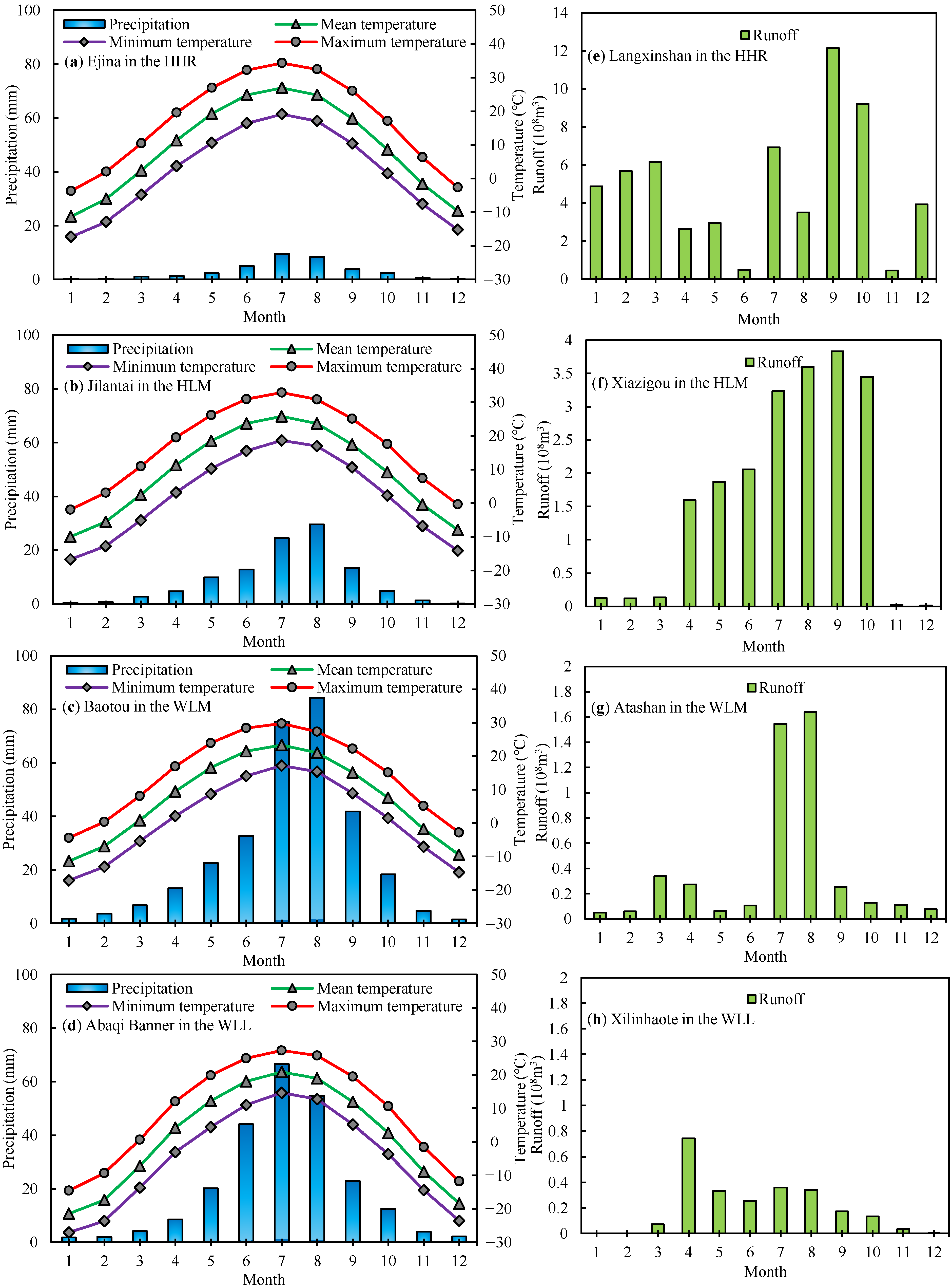
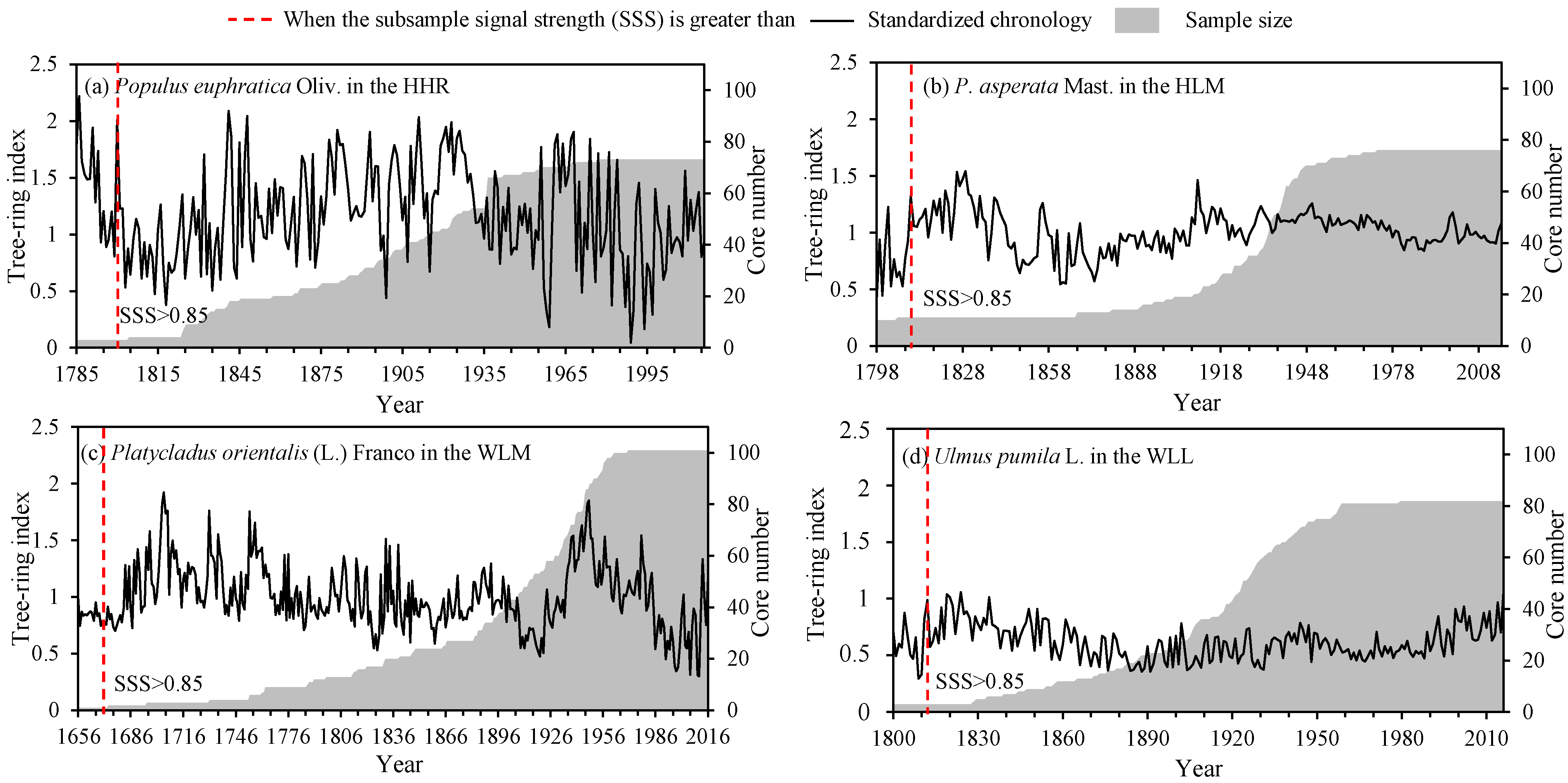
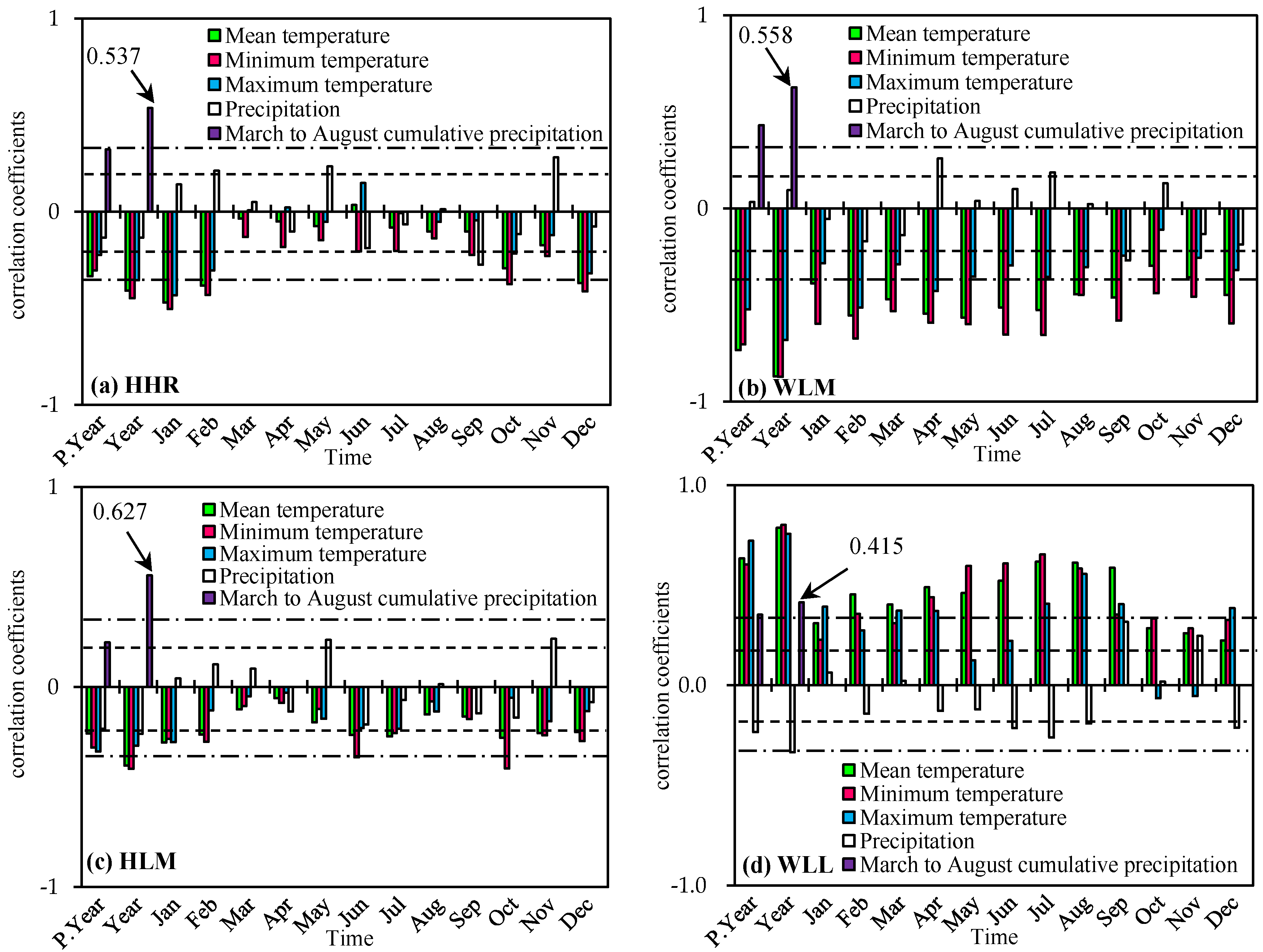

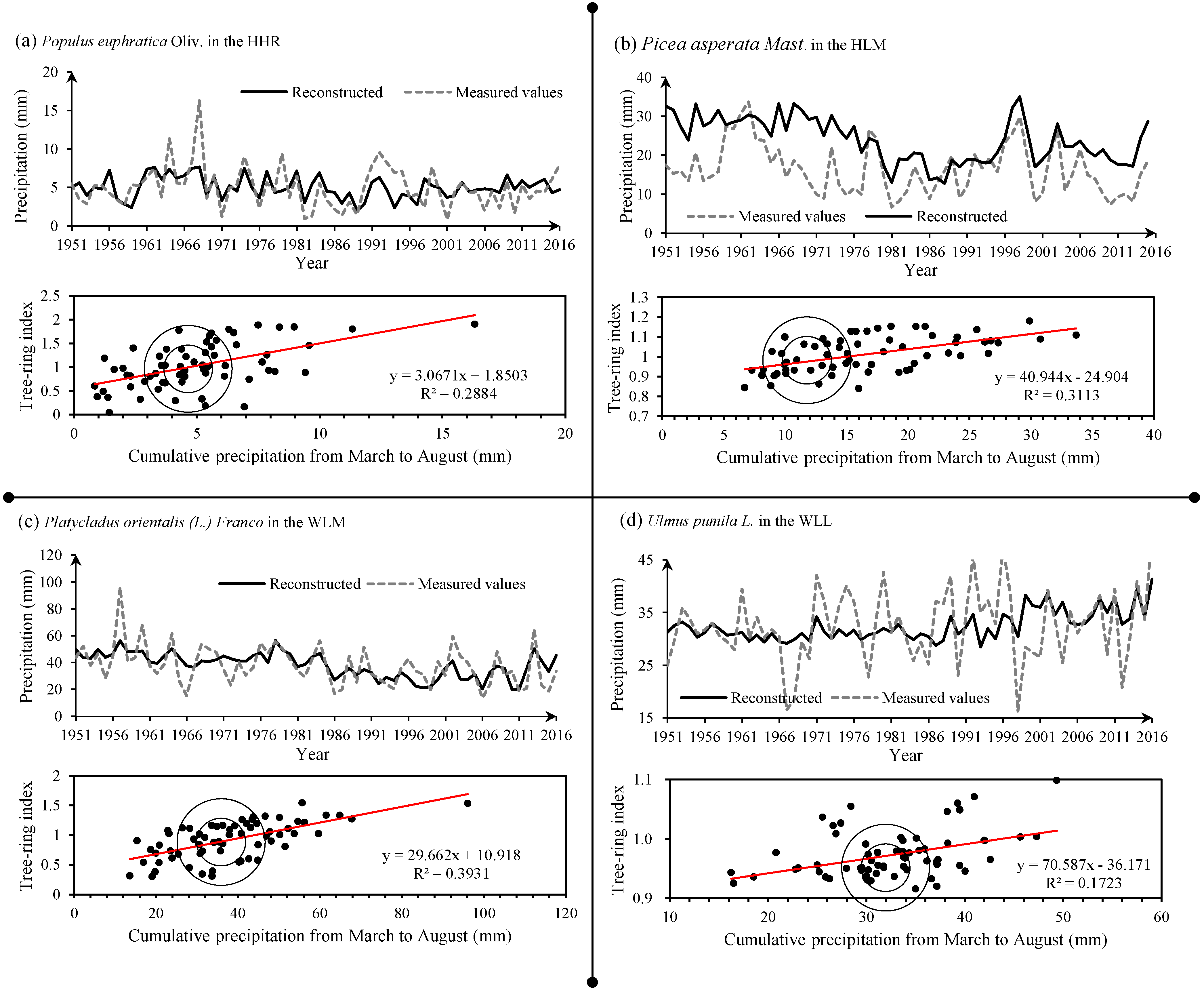

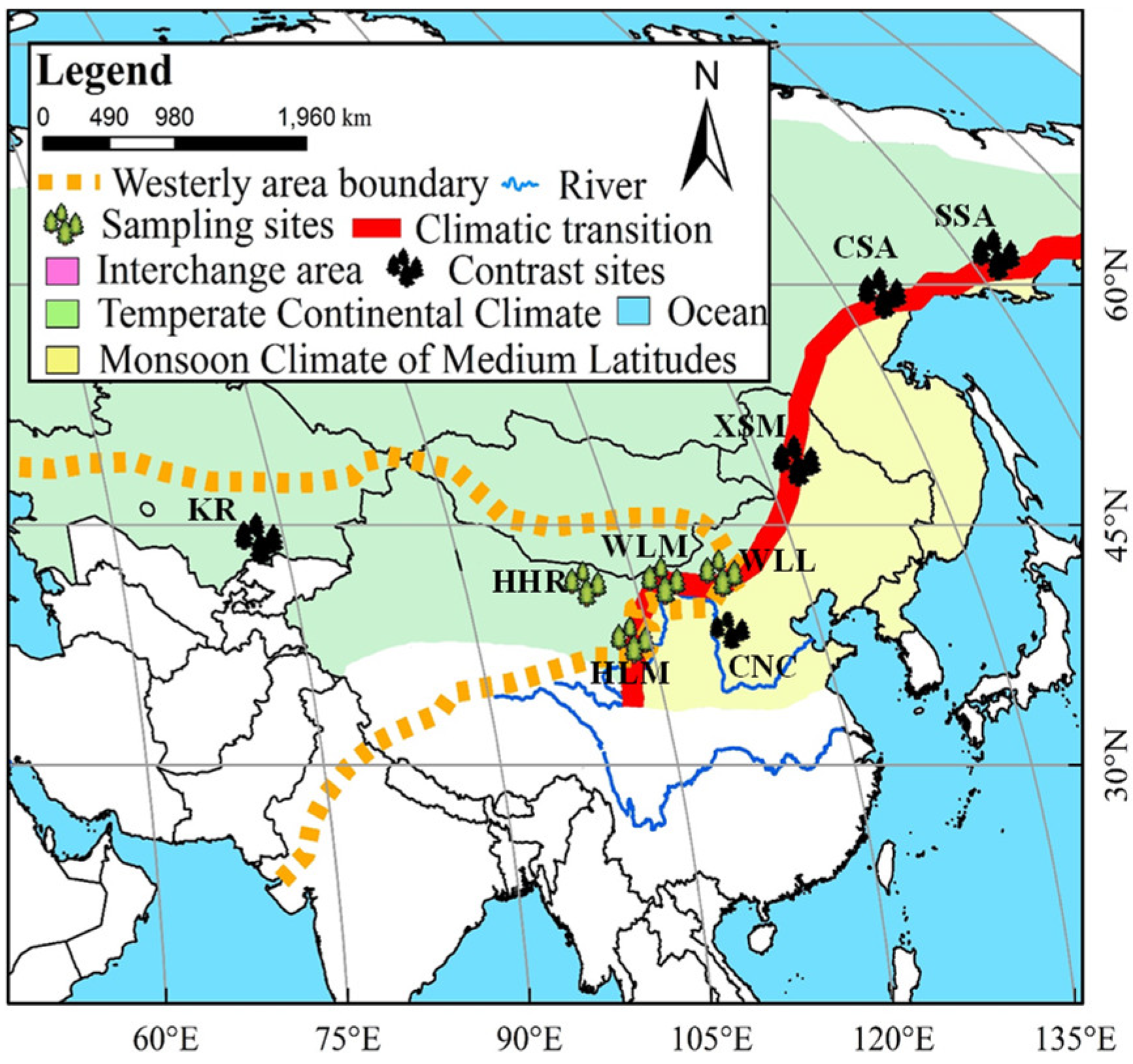
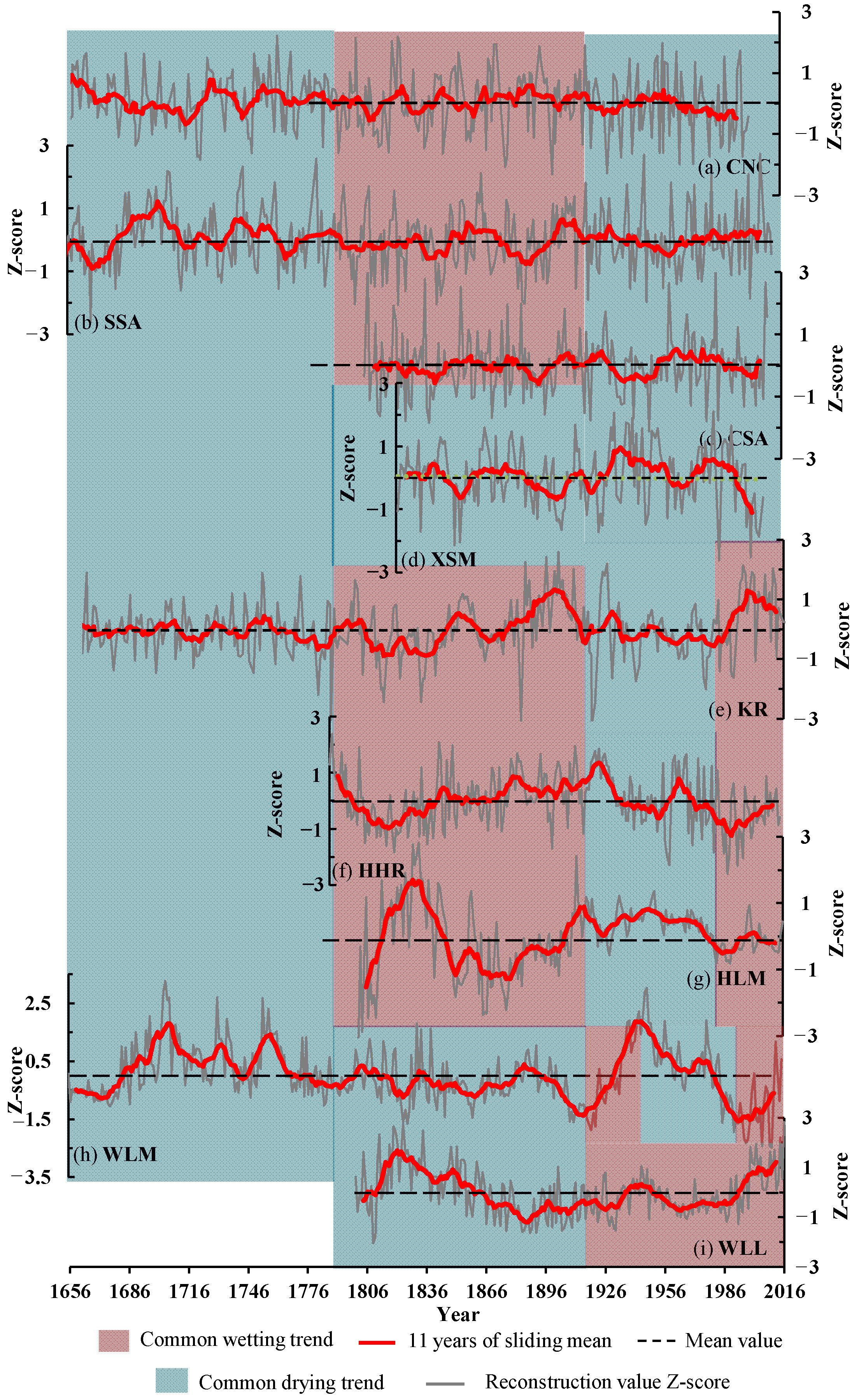
| Short for Sampling Place | Sample Tree Species | Longitude and Latitude | Mean Elevation | Time of Sampling | Sample Plant (Tree) | Sample Core (Root) | Average Tree Diameter (cm) | Average Tree Height (m) | Canopy Closure (%) | Slope |
|---|---|---|---|---|---|---|---|---|---|---|
| HHR | Populus euphratica, Oliv | 101°09′33″ E 41°59′09″ N | 1011 | 8, 2017 | 31 | 62 | 91.2 | 14.5 | 60 | 10°~15° |
| HLM | Picea asperata Mast. | 105°47′47″ E 38°39′42″ N | 2334 | 7, 2017 | 38 | 76 | 45.5 | 6.4 | 58 | 25°~35° |
| WLM | Platycladus orientalis (L.) Franco | 109°24′11″ E 40°42′12″ N | 1780 | 7, 2017 | 49 | 105 | 28.9 | 3.9 | 58 | 35°~38° |
| WLL | Ulmus pumila L. | 116°26′28″ E 42°19′15″ N | 988 | 8, 2017 | 41 | 87 | 52.6 | 13.7 | 65 | 15°~20° |
| Combined | 159 | 330 |
| Statistical Indicators | Statistic | |||
|---|---|---|---|---|
| HHR | HLM | WLM | WLL | |
| Average value | 1.000 | 1.000 | 1.000 | 1.000 |
| Median | 0.832 | 0.745 | 0.941 | 0.843 |
| Skewness | 0.939 | 0.363 | 0.987 | 0.746 |
| Kurtosis | 1.974 | 1.159 | 1.974 | 1.832 |
| Mean sensitivity | 0.363 | 0.426 | 0.193 | 0.326 |
| Standard deviation | 0.332 | 0.153 | 0.312 | 0.388 |
| The first-order autocorrelation coefficient | 0.504 (p < 0.01) | 0.651 (p < 0.01) | 0.604 (p < 0.01) | 0.560 (p < 0.01) |
| The average correlation coefficient between each sequence and the main sequence | 0.561 | 0.657 | 0.661 | 0.671 |
| Mean correlation coefficient between trees | 0.438 | 0.434 | 0.359 | 0.539 |
| SNR (signal to noise ratio) | 13.122 | 16.158 | 15.122 | 14.133 |
| Overall representativeness of samples | 0.724 | 0.946 | 0.925 | 0.691 |
| The first principal component explains the variance % | 41.672 | 20.351 | 40.384 | 53.424 |
| First year of subsample with signal strength > 0.85 | 1796 | 1788 | 1666 | 1813 |
| Serial Number | The Reconstruction Equation | r | N | R2adj | F | Significance Level | RE | CE |
|---|---|---|---|---|---|---|---|---|
| HHR | 0.537 | 66 | 0.334 | 25.94 | p < 0.001 | 0.832 | 0.663 | |
| HLM | 0.558 | 0.423 | 27.64 | 0.733 | 0.423 | |||
| WLM | 0.627 | 0.601 | 41.52 | 0.803 | 0.337 | |||
| WLL | 0.415 | 0.424 | 13.32 | 0.715 | 0.334 |
Disclaimer/Publisher’s Note: The statements, opinions and data contained in all publications are solely those of the individual author(s) and contributor(s) and not of MDPI and/or the editor(s). MDPI and/or the editor(s) disclaim responsibility for any injury to people or property resulting from any ideas, methods, instructions or products referred to in the content. |
© 2023 by the authors. Licensee MDPI, Basel, Switzerland. This article is an open access article distributed under the terms and conditions of the Creative Commons Attribution (CC BY) license (https://creativecommons.org/licenses/by/4.0/).
Share and Cite
Sun, B.; Ma, L.; Liu, T.; Huang, X. Growth-Season Precipitation Variations in the Joint Area between the Asian Westerly Jet Area and the Climate Transition Zone over the Past Two Centuries. Forests 2023, 14, 111. https://doi.org/10.3390/f14010111
Sun B, Ma L, Liu T, Huang X. Growth-Season Precipitation Variations in the Joint Area between the Asian Westerly Jet Area and the Climate Transition Zone over the Past Two Centuries. Forests. 2023; 14(1):111. https://doi.org/10.3390/f14010111
Chicago/Turabian StyleSun, Bolin, Long Ma, Tingxi Liu, and Xing Huang. 2023. "Growth-Season Precipitation Variations in the Joint Area between the Asian Westerly Jet Area and the Climate Transition Zone over the Past Two Centuries" Forests 14, no. 1: 111. https://doi.org/10.3390/f14010111
APA StyleSun, B., Ma, L., Liu, T., & Huang, X. (2023). Growth-Season Precipitation Variations in the Joint Area between the Asian Westerly Jet Area and the Climate Transition Zone over the Past Two Centuries. Forests, 14(1), 111. https://doi.org/10.3390/f14010111




